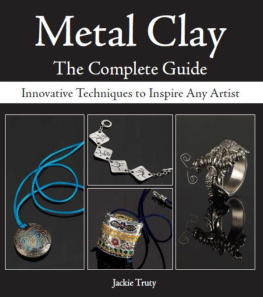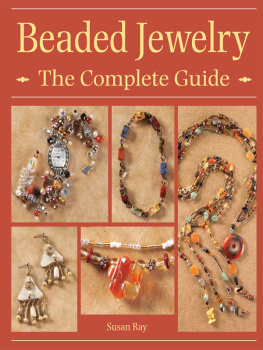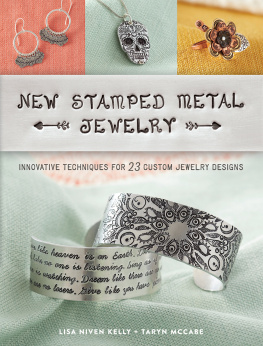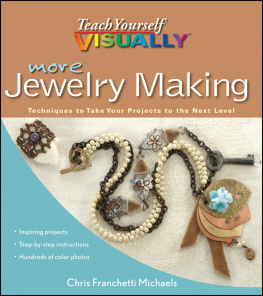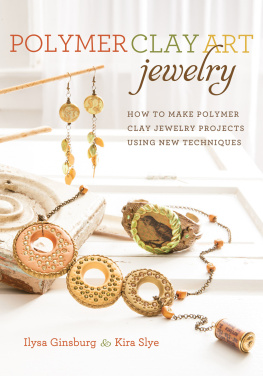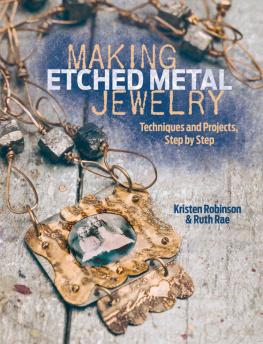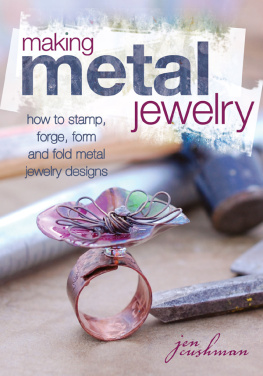Sculptural
Metal Clay
Jewelry
TECHNIQUES + EXPLORATIONS
KATE MCKINNON


Contents

THIS BOOK IS A POEM to the possibilities of pure fine silver, which is too often overlooked by traditional metalsmiths. Fine silver is just pure silver, with nothing added or alloyed to it, and it comes in many forms. Fine silver metal clay can be textured, sculpted, hand built, or coaxed into almost any shape imaginable, and, if properly worked and fired, can be almost as dense and durable as cast metal. Pure fine silver wire or sheet can not only be joined in the flame, or fused, without using solder or flux, but can also be imbedded into metal clay work and bonded in the kiln. This allows you to bring the solid structure of pulled or rolled metal to support your sculptural metal clay pieces, forming ring shanks, posts, armatures and prong settings.
The use of pure silver, whether in clay, sheet metal, or wire form, not only eliminates the need for solder or chemicals at the bench, it offers freedom from the time-consuming (and dirty) process of cleaning and polishing back the blackening that comes from heating alloys like sterling silver. When using fine silver, I can work metal from beginning to end safely and cleanly. I can make, in just a few hours, complex and detailed finished pieces, any one of which can be used as a prototype for casting if I wish. No wax carving is necessary, and my casting models are permanent works, not burned away in the molding process.
If youve ever done any traditional metalsmithing, those two paragraphs might sound revolutionary. Most people who work metal havent been taught that fine silver can be fused, instead of soldered, or have been told that it is too soft to make real jewelry with. It isnt. You just have to make things slightly more solid, or thicker in gauge. Properly handled, sized, and work-hardened, fine silver can serve beautifully, even in high-stress positions like ring bands and chain.
Although many talented artisans are working with fine silver wire and metal clay, I find that two vitally important steps in understanding and working any metal are often left out of most books and classes on metal clay: annealing and forging. For example, few metal clay artisans are aware of the true reason that a full firing is so important: the benefit of a deep annealing soak. Even fewer are aware that they can melt their scrap, cast it into an ingot of pure silver, and then roll their own fine silver sheet or draw their own wire.

Although some of the projects presented in this book may seem complex if you are a beginner, they are just progressions of simple steps, and anyone can make them. No special equipment is required other than a set of basic clay tools, pliers, and cutters, and access to a digitally controlled kiln. Each technique and project, in addition to showing the simplest path to completion, also shows many variations. Ill encourage you to practice basic skills, no matter what your level of experience: to find body memory for your tasks, to solidify your skills, and to add a meditative quality to your work that can lead you to a well of original ideas.
A helpful section in the front of the book explains fine silver metal clay from the particles on up: what it is and why full firing, annealing, and work-hardening are so important. Theres a handy glossary of terms, both for metalsmithing and for clay work, and a series of techniques and projects meant to build your skills as a craftsperson.

The techniques you use in your craft are your own playground, your laboratory, your teachers, your magic circle. Only when you fully inhabit them do they become your own, so give yourself to each one, and practice them until your fingers know the way.
Youll be swimming in ideas. I promise.
KATE McKINNON

The more I work with fine silver metal clay, the more possibilities I see, and the more interesting it becomes. I began using it in 1997, when I wanted to make my own specialty clasps and connecting elements for my beadwork. After exploring it for a year or so, I began learning traditional metalsmithing techniques so that Id have a better understanding of my options for making cleaner connections and stronger pieces.
Fine silver metal clay is a valuable addition to any jewelers bench, and its not only possible, but delightful, to make finished work of professional quality in pure fine silver. Alloys like sterling silver are lovely in context and offer technical benefits in strength and durability, but in my opinion, nothing compares to the depth and beauty of pure silver. The time spent mastering the somewhat different skill sets to work with it is well worth your while.
I work with metal clay very simply and cleanly, and nothing I do is particularly complex or difficult. I dont add anything to it, and I try to move quickly and deliberately to my forms, without overhandling. My techniques for forming the clay are all classic hand-building skills, and I work with the clay differently in each of the basic stages of dryness. Throughout the book Ill point out to you which things work better in these different stages.
I encourage you to explore even the most basic tasks fully. You havent really rolled a ball of clay, for example, until youve rolled an utterly smooth, totally compressed egg of clay with just a few motions. Ideally, your work will be so neatly made that youll never be forced to sand or file a single piece of dry or fired metal clay unless you choose to do so. Doing potentially dangerous things with any material should be a choice, not a default. In general, the less you file and sand metal clay or metal, the healthier you and your work environment will be.
What Is Metal Clay?
Its important to remember that metal clay really is metal. Even though its in a flexible binder material and behaves much like any other type of clay, its made up of many tiny particles of silver. Its your job to keep those particles as tightly packed together as possible, and, when firing your pieces, to give them enough heat, for enough time, for the zillions of tiny particles of metal bond to form as dense a finished piece as possible. This is why I will repeatedly encourage you to do things that compress, rather than stretch, your clay, and to fire your work fully (for 2 hours, at 1650 F [899 C]) to allow the pieces enough time in the kiln to be dense and strong enough to forge, size, and work at your bench. Many people are taught to routinely short-fire or underfire their metal clay and this is unfortunate, as it deprives them of the opportunity to work with the finished pieces like a metalsmith would.
There are various silver clay formulas on the market, each with slightly different particle sizes and binder compositions, but they all behave the same once their binder materials are burned out in the kiln. That happens rather quickly, at about 700800 F (371427 C). After the binder flames out, the process of






